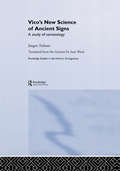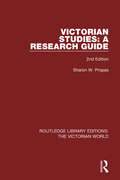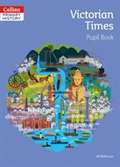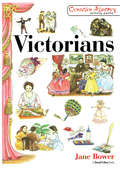- Table View
- List View
A Vicarage Family: A Biography Of Myself (A Puffin Book #70)
by Noel Streatfeild N AA Vicarage Family is the first part in a fictionalized autobiography in which Noel Streatfeild tells the story of her own childhood, painting a poignant and vivid picture of daily life in an impoverished, genteel family in the years leading up to the First World War.In the story there are three little girls - Isobel, the eldest, is pretty, gentle and artistic; Louise the youngest, is sweet and talented - and then there is Vicky, 'the plain one', the awkward and rebellious child who doesn't fit in at school or at home. Growing up in a big family Vicky feels overlooked but gradually begins to realize that she might not be quite as untalented as she feels.The Vicky of this story is, of course, the much-loved Noel Streatfeild who went on to write so many wonderful family stories, the most famous being Ballet Shoes.
Vico's New Science of Ancient Signs: A Study of Sematology
by Jürgen TrabantJürgen Trabant reads the profound insights into human semiosis contained in Vico's 'sematology' as both a spirited rejection of Cartesian philosophy and an early critique of enlightened logocentricism. Sean Ward's translation makes this work available to an English-reading audience for the first time.
Vico's New Science of Ancient Signs: A Study of Sematology
by Jürgen TrabantJürgen Trabant reads the profound insights into human semiosis contained in Vico's 'sematology' as both a spirited rejection of Cartesian philosophy and an early critique of enlightened logocentricism. Sean Ward's translation makes this work available to an English-reading audience for the first time.
Victim and Victimizer: Joseph's Interpretation of his Destiny (The Library of Hebrew Bible/Old Testament Studies)
by Yiu-Wing FungThis book attempts an interesting exercise in character analysis. It scrutinizes the speeches of Joseph in such a way as to expose the problematic nature of his claims to know God's intentions. While Judah is forced by Joseph's test to choose slavery for the sake of his father's survival, the ironic reversal of Judah's role from victimizer to victim is undercut by the rationale by which he had Joseph sold in order to save him. Unwittingly, Joseph mistakes this rationale as a divine principle that undergirds his suffering and he dreams of domination for the same purpose of survival. He is unaware of Judah's real predicament and this double blindness calls into doubt the coalescence of perspectives of Joseph and the narrator.
Victimization in Schools (Law, Society and Policy #2)
by Gary D. Gottfredson Denise C. GottfredsonThe perception that our nation's public schools are disorderly and unsafe is widespread, and the image of the public school is deteriorating. Since 1974, the Gallup organization has gathered opinions about the public schools. The percentage giving the schools an "A" rating declined from 18% to 6% between 1974 and 1983 (Gallup, 1974, 1984). In a recent survey of America's teenagers, only 9% gave the schools an "A" rating (Bahner, 1980, p. 106). Lack of discipline tops the list of the problems adults see facing schools, and class disturbances and theft are reported by teenagers to be "very big" or "fairly big" problems in their schools (Bahner, 1980, p. 107). These public perceptions are fostered by and reflected in national media attention ("City Schools in Crisis," 1977; "Help! Teacher Can't Teach!" 1980; "High Schools under Fire," 1977). Public concern is also reflected in Congressional hearings where testimony creates the image of grave disorder within our schools (U.s. Senate, Committee on the Judiciary, 1975, 1976b; U.s. House of Representatives, Subcommittee on Elementary, Secondary, and Vocational Education, 1980). The public has given the schools low marks, and the Senate Judiciary Committee (1975) gave the schools an" A" in violence and vandalism. In short, parents, students, and public officials are alarmed at what they see as a rising tide of violence and disorder in the schools and are concerned about how much learning can occur in a disruptive environ ment, and about the safety of teachers and students.
The Victorian Art School: Architecture, History, Environment
by Ranald LawrenceThe Victorian Art School documents the history of the art school in the nineteenth century, from its origins in South Kensington to its proliferation through the major industrial centres of Britain. Charles Rennie Mackintosh’s Glasgow School of Art, together with earlier examples in Manchester and Birmingham demonstrate an unprecedented concern for the provision of plentiful light and air amidst the pollution of the Victorian city. As theories of design education and local governance converged, they also reveal the struggle of the provincial city for cultural independence from the capital. Examining innovations in the use of new technologies and approaches in the design of these buildings, The Victorian Art School offers a unique and explicitly environmental reading of the Victorian city. It examines how art schools complemented civic ‘Improvement’ programmes, their contribution to the evolution of art pedagogy, the tensions that arose between the provincial schools and the capital, and the role they would play in reimagining the relationship between art and public life in a rapidly transforming society. The architects of these buildings synthesised the potential of art with the perfection of the internal environment, indelibly shaping the future cultural life of Britain.
The Victorian Art School: Architecture, History, Environment
by Ranald LawrenceThe Victorian Art School documents the history of the art school in the nineteenth century, from its origins in South Kensington to its proliferation through the major industrial centres of Britain. Charles Rennie Mackintosh’s Glasgow School of Art, together with earlier examples in Manchester and Birmingham demonstrate an unprecedented concern for the provision of plentiful light and air amidst the pollution of the Victorian city. As theories of design education and local governance converged, they also reveal the struggle of the provincial city for cultural independence from the capital. Examining innovations in the use of new technologies and approaches in the design of these buildings, The Victorian Art School offers a unique and explicitly environmental reading of the Victorian city. It examines how art schools complemented civic ‘Improvement’ programmes, their contribution to the evolution of art pedagogy, the tensions that arose between the provincial schools and the capital, and the role they would play in reimagining the relationship between art and public life in a rapidly transforming society. The architects of these buildings synthesised the potential of art with the perfection of the internal environment, indelibly shaping the future cultural life of Britain.
Victorian Class Conflict?: Schoolteaching & the Parson, Priest & Minister, 1837-1902 (pdf)
by John T SmithVillages and towns in the Victorian era saw a great expansion in educational provision, and witnessed the rise of the elementary teaching profession, often provided and supported by local clergymen. This book investigates the social and economic relationships of such clergymen and teachers who worked co-operatively and at times in competition with each other, their relative positions typified by the comment of one contemporary clergyman as 'those of master and servant'. The inevitable result was a complex of movements in society in the final third of the nineteenth century that led to increasing clashes in villages, as one group (the clergy) sought to preserve its hold on its status and power, while the other (male and female teachers) attempted to secure their new role in society. The research presented is based on previously unused, original sources -- church documents, HMI reports, newspapers and journals and private papers. It is not confined, as is the case with so much recent research, to the Church of England, but breaks new ground in providing a comparative analysis of the social position and educational work of Roman Catholic and Wesleyan clergy, and their collaboration with their elementary school teachers. This book is essential reading for all those interested in Victorian Education.
Victorian Culture and Experiential Learning: Historical Encounters in the Classroom
by Kevin A. MorrisonThis book is a crucial resource for instructors interested in bringing the past alive for their students through hands-on, immersive educational experiences. While sharing a common historical field, the contributors hail from multiple disciplines, including art history, human biology, biological anthropology, and English literature. Ranging from assignments that involve students editing and annotating a primary work to producing an array of digital projects, and from participating in study-abroad programs to taking part in service-learning initiatives, the chapters will furnish readers with strategies for creating engaged and dynamic classrooms. Although the focus of the book is on Victorian Britain, the pedagogical approaches outlined in each chapter will be useful to instructors of any historical field.
Victorian Education and the Ideal of Womanhood (Routledge Library Editions: Education 1800-1926)
by Joan N. BurstynThis study, first published in 1980, argues that higher education for women was accepted by the end of the nineteenth-century, and higher education was becoming a desirable preparation for teachers in girls’ schools. By accepting the opponents’ claim that higher education for women had the potential to revolutionise relations between the sexes, this fascinating book demonstrates how the relevance of the nineteenth-century serves to enhance our understanding of the contemporary women’s movement. This title will be of interest to students of history and education.
Victorian Education and the Ideal of Womanhood (Routledge Library Editions: Education 1800-1926)
by Joan N. BurstynThis study, first published in 1980, argues that higher education for women was accepted by the end of the nineteenth-century, and higher education was becoming a desirable preparation for teachers in girls’ schools. By accepting the opponents’ claim that higher education for women had the potential to revolutionise relations between the sexes, this fascinating book demonstrates how the relevance of the nineteenth-century serves to enhance our understanding of the contemporary women’s movement. This title will be of interest to students of history and education.
A Victorian Educational Pioneer’s Evangelicalism, Leadership, and Love: Maynard’s Mistakes
by Pauline A. PhippsThis book examines the relatively unknown English late-Victorian educational pioneer, Constance Louisa Maynard (1849-1935), whose innovative London-based Westfield College produced the first female BAs in the mid-1880s. An atypical and powerful woman, Maynard is also notable for her unique knowledge of psychology and patriotic Evangelicalism, both of which profoundly shaped her ambitions and passions. In contrast to most history about an individual’s life, this book builds a fascinating life story based upon evidence and clues from minutia. The focus is on nine enigmatic actions motivated by Maynard in her quests for educational leadership, global conversion, and same-sex love. Maynard’s acts that she called “mistakes,” caused deep enmities with administrators and college women. Yet amid her trials and conflicts Maynard made key decisions about her public and private life. Moreover, her so-called mistakes reveal astonishing new insights into a past mindset and the rapidly changing world in which Maynard lived.
Victorian Interpretation
by Suzy AngerSuzy Anger investigates the relationship of Victorian interpretation to the ways in which literary criticism is practiced today. Her primary focus is literary interpretation, but she also considers fields such as legal theory, psychology, history, and the natural sciences in order to establish the pervasiveness of hermeneutic thought in Victorian culture. Anger's book demonstrates that much current thought on interpretation has its antecedents in the Victorians, who were already deeply engaged with the problems of interpretation that concern literary theorists today.Anger traces the development and transformation of interpretive theory from a religious to a secular (and particularly literary) context. She argues that even as hermeneutic theory was secularized in literary interpretation it carried in its practice some of the religious implications with which the tradition began. She further maintains that, for the Victorians, theories of interpretation are often connected to ethical principles and suggests that all theories of interpretation may ultimately be grounded in ethical theories.Beginning with an examination of Victorian biblical exegesis, in the work of figures such as Benjamin Jowett, John Henry Newman, and Matthew Arnold, the book moves to studies of Thomas Carlyle, George Eliot, and Oscar Wilde. Emphasizing the extent to which these important writers are preoccupied with hermeneutics, Anger also shows that consideration of their thought brings to light questions and qualifications of some of the assumptions of contemporary criticism.
Victorian School Manager
by Peter GordonFirst published in 1974. Routledge is an imprint of Taylor & Francis, an informa company. Graham Balfour, in a lecture delivered in February 1921, first drew attention to the growing importance of the elementary school manager in the system of educational administration during the period with which this study is concerned: “Local administrators of education, other than trustees a hundred years ago, there were none. Indeed it is very curious how imperceptibly that important figure of the latter half of the nineteenth century, the School Manager, steals into existence.
Victorian School Manager
by Peter GordonFirst published in 1974. Routledge is an imprint of Taylor & Francis, an informa company. Graham Balfour, in a lecture delivered in February 1921, first drew attention to the growing importance of the elementary school manager in the system of educational administration during the period with which this study is concerned: “Local administrators of education, other than trustees a hundred years ago, there were none. Indeed it is very curious how imperceptibly that important figure of the latter half of the nineteenth century, the School Manager, steals into existence.
Victorian Studies: A Research Guide (Routledge Library Editions: The Victorian World)
by Sharon W. PropasFirst published in 2006, this work is a valuable guide for the researcher in Victorian Studies. Updated to include electronic resources, this book provides guides to catalogs, archives, museums, collections and databases containing material on the Victorian period. It organises the vast array of reference sources by discipline to help researchers tailor their investigations.
Victorian Studies: A Research Guide (Routledge Library Editions: The Victorian World)
by Sharon W. PropasFirst published in 2006, this work is a valuable guide for the researcher in Victorian Studies. Updated to include electronic resources, this book provides guides to catalogs, archives, museums, collections and databases containing material on the Victorian period. It organises the vast array of reference sources by discipline to help researchers tailor their investigations.
The Victorian Times (Collins Primary History Ser.)
by Alf WilkinsonCollins Primary History provides a rich coverage of the Primary National Curriculum for History. Packed with information, source materials, questions and activities, the beautifully designed pupil books support children to explore, interpret and develop knowledge of significant historical periods. The accompanying Teacher's Guide provides planning support and guidance on making progress in history.
Victorians
by Jane BowerThe innovative Creative History Activity Packs series is designed to help teachers bring history topics to life through imaginative creative arts activities. Each pack includes ten laminated, double-sided cards, printed in full color. Each card describes in detail activities that recreate aspects of life in a particular historical period, using art, drama and dance. Each activity is based on historically researched authentic practices of the time. Ideal for whole class or small group sessions, the packs are an inspiration for busy teachers looking for new ways to approach project work at Key Stage 2 - and are easily applicable for Key Stage 1 classes. Victorian activities in this pack include making decorative objects - penwipers, fans, cornucopias - based on original Victorian patterns; sewing samplers; making miniature gardens; original Victorian parlor games based on both wordplay and physical activity; and an upstairs/downstairs drama.
Victorians (Creative History Activity Packs Ser.)
by Jane BowerThe innovative Creative History Activity Packs series is designed to help teachers bring history topics to life through imaginative creative arts activities. Each pack includes ten laminated, double-sided cards, printed in full color. Each card describes in detail activities that recreate aspects of life in a particular historical period, using art, drama and dance. Each activity is based on historically researched authentic practices of the time. Ideal for whole class or small group sessions, the packs are an inspiration for busy teachers looking for new ways to approach project work at Key Stage 2 - and are easily applicable for Key Stage 1 classes. Victorian activities in this pack include making decorative objects - penwipers, fans, cornucopias - based on original Victorian patterns; sewing samplers; making miniature gardens; original Victorian parlor games based on both wordplay and physical activity; and an upstairs/downstairs drama.
Victorians
by Ian Roberts Brian MosesThis book will support children as they: * Write a school report for a Victorian pupil * Compile the biography of a real-life circus performer- "The Human Canon Ball" * Produce a letter to complain about the after-effects of the Victorian remedy carbolic smoke balls!
Victorians
by Ian Roberts Brian MosesThis book will support children as they: * Write a school report for a Victorian pupil * Compile the biography of a real-life circus performer- "The Human Canon Ball" * Produce a letter to complain about the after-effects of the Victorian remedy carbolic smoke balls!
Victory Against Japan 1944-1945: (WW2 #12) (The Ladybird Expert Series #18)
by James HollandBOOK 12 OF THE LADYBIRD EXPERT HISTORY OF THE SECOND WORLD WAR, FROM AWARD-WINNING HISTORIAN JAMES HOLLANDFeaturing stunning illustrations from Keith Burns, bringing the story to life in vivid detailWhy did Japan decide to attack at Pearl Harbour?What was the Japanese vision of a Greater Asian Co-Prosperity Sphere?How did the American strategy turn the tide against Japanese offensives?Uncover the complexities of the brutal war against Japan.From the surprise attack on Pearl Harbour, Oahu, to the Philippines Campaign, the Allies were finally able to turn the tide against the onslaught of Japanese forces.Ending in Japanese surrender after the devastating atomic bombings of Nagasaki and Hiroshima, the war in Japan was eventually won, but at the cost of civilian lives.THE WAR THAT LED TO TWO ATOMIC BOMBINGSWritten by historian, author and broadcaster James Holland, Victory Against Japan is an essential introduction to the tactics that finally brought an end to the Second World War.__________Discover the full Ladybird Expert WW2 series:BlitzkriegThe Battle of BritainBattle of the AtlanticThe Desert WarThe Eastern FrontThe Pacific WarThe Bomber WarThe War in ItalyThe Battle for NormandyThe War in BurmaVictory in EuropeVictory Against Japan
Victory in Europe 1944-1945: (WW2 #11) (The Ladybird Expert Series #17)
by James HollandBOOK 11 OF THE LADYBIRD EXPERT HISTORY OF THE SECOND WORLD WAR, FROM AWARD-WINNING HISTORIAN JAMES HOLLANDFeaturing stunning illustrations from Keith Burns, bringing the story to life in vivid detailWhat was Operation Bagration?Why did the Warsaw Uprising fail?How were the Nazis finally crushed?BRITAIN'S VICTORY IN EUROPE was a pivotal moment in the impending end of WW2, but it was no easy feat.With most of Europe under Axis control, the Allies battled through the brutal winter of 1945 to overcome German forces and finally defeat Hitler.THE PINNACLE MOMENT IN BRITAIN'S WW2 SUCCESSWritten by historian, author and broadcaster James Holland, Victory in Europe is an essential, accessible introduction to Britain's triumph over the Nazis.__________Discover the full Ladybird Expert WW2 series:BlitzkriegThe Battle of BritainBattle of the AtlanticThe Desert WarThe Eastern FrontThe Pacific WarThe Bomber WarThe War in ItalyThe Battle for NormandyThe War in BurmaVictory in EuropeVictory Against Japan
Video Analysis and Repackaging for Distance Education
by A. Ranjith Ram Subhasis ChaudhuriThis book presents various video processing methodologies that are useful for distance education. The motivation is to devise new multimedia technologies that are suitable for better representation of instructional videos by exploiting the temporal redundancies present in the original video. This solves many of the issues related to the memory and bandwidth limitation of lecture videos. The various methods described in the book focus on a key-frame based approach which is used to time shrink, repackage and retarget instructional videos. All the methods need a preprocessing step of shot detection and recognition, which is separately given as a chapter. We find those frames which are well-written and distinct as key-frames. A super-resolution based image enhancement scheme is suggested for refining the key-frames for better legibility. These key-frames, along with the audio and a meta-data for the mutual linkage among various media components form a repackaged lecture video, which on a programmed playback, render an estimate of the original video but at a substantially compressed form. The book also presents a legibility retentive retargeting of this instructional media on mobile devices with limited display size. All these technologies contribute to the enhancement of the outreach of distance education programs. Distance education is now a big business with an annual turnover of over 10-12 billion dollars. We expect this to increase rapidly. Use of the proposed technology will help deliver educational videos to those who are less endowed in terms of network bandwidth availability and to those everywhere who are even on a move by delivering it effectively to mobile handsets (including PDAs). Thus, technology developers, practitioners, and content providers will find the material very useful.

















